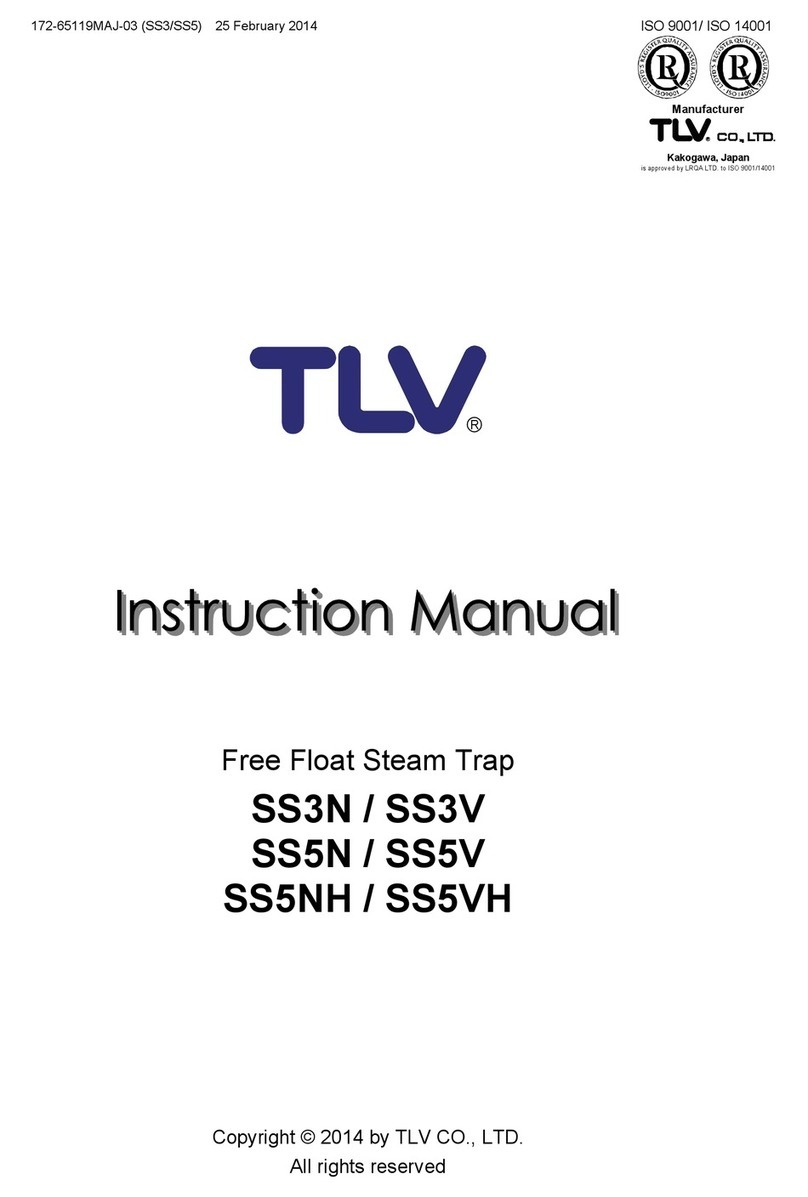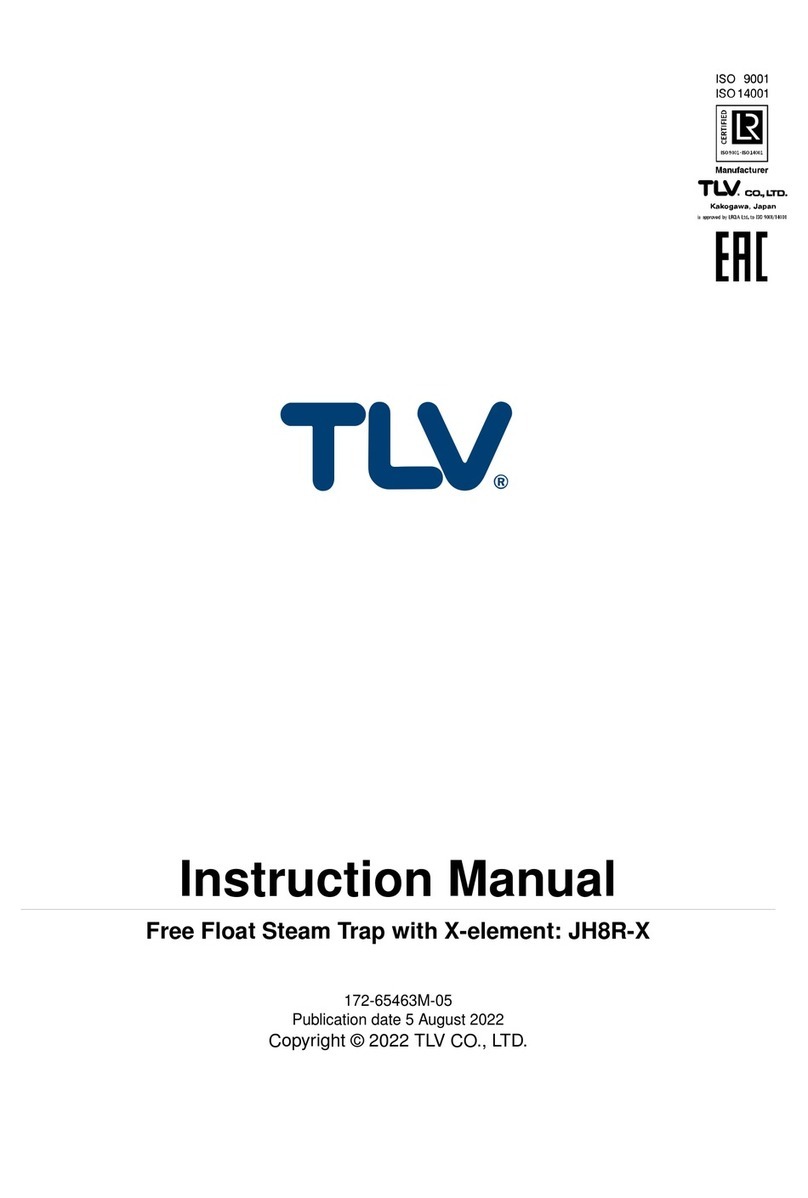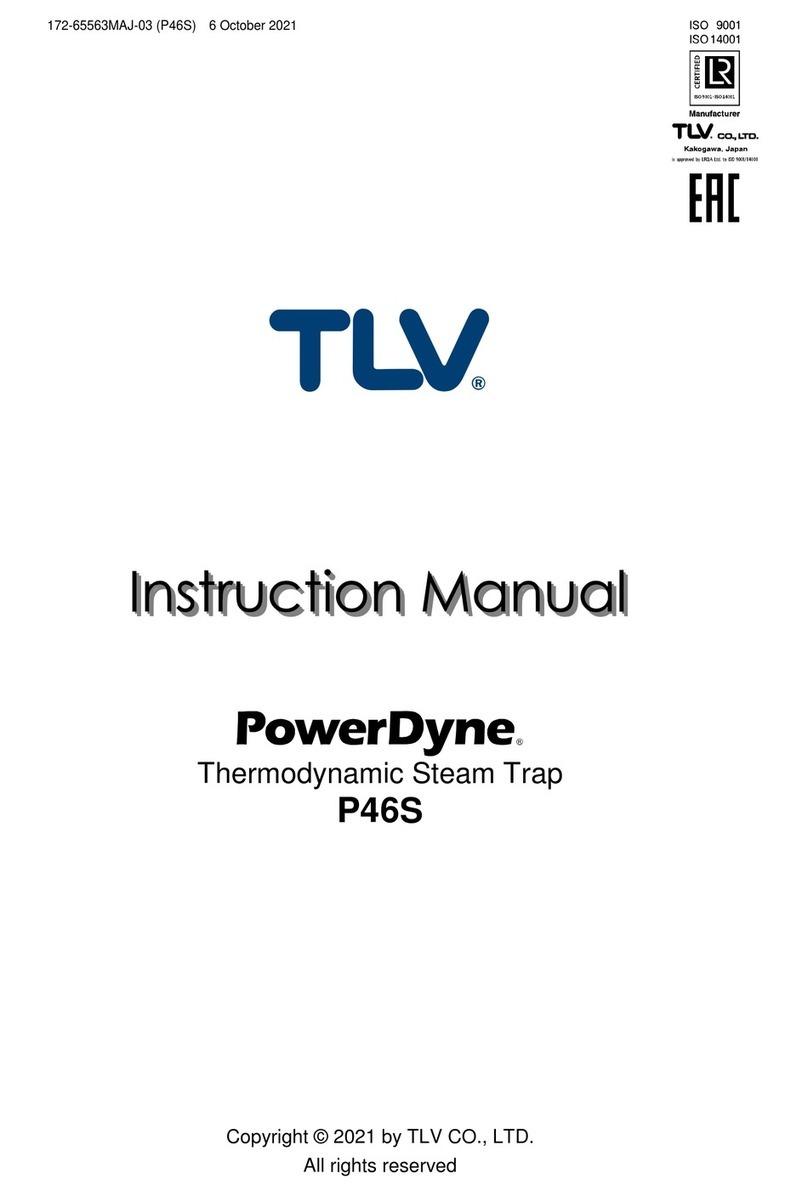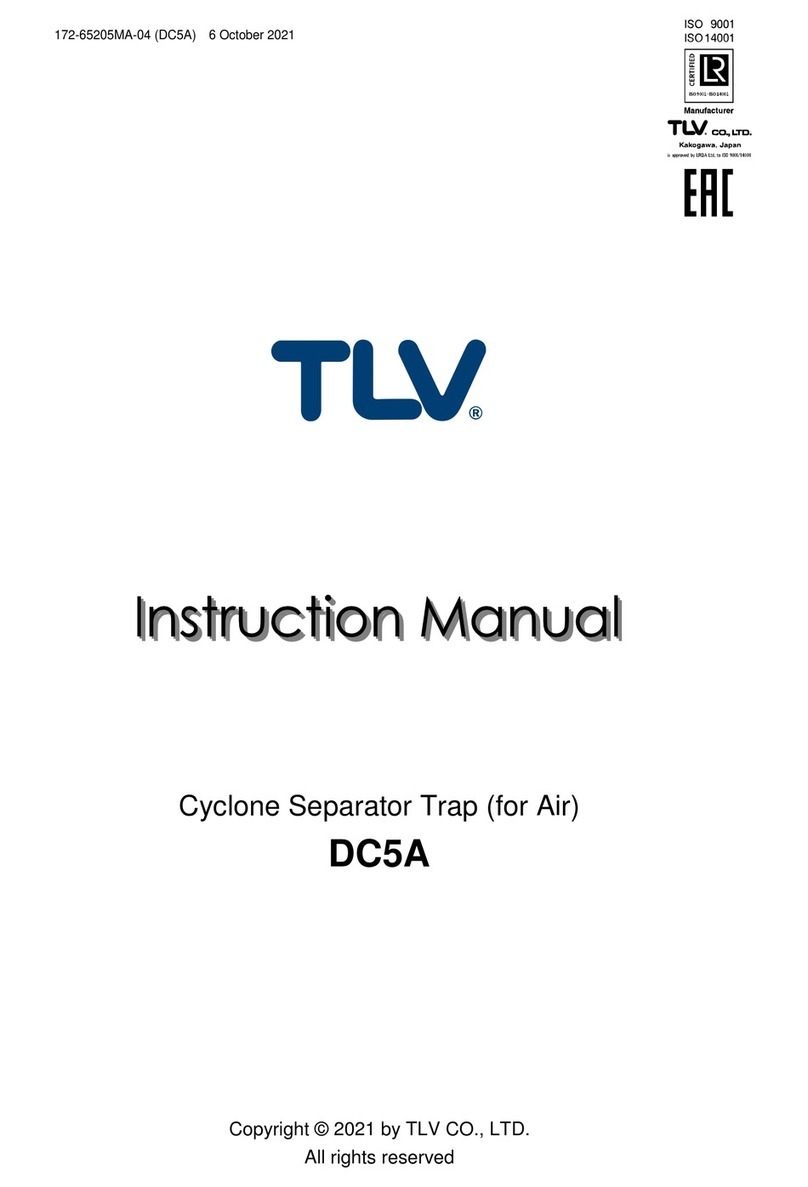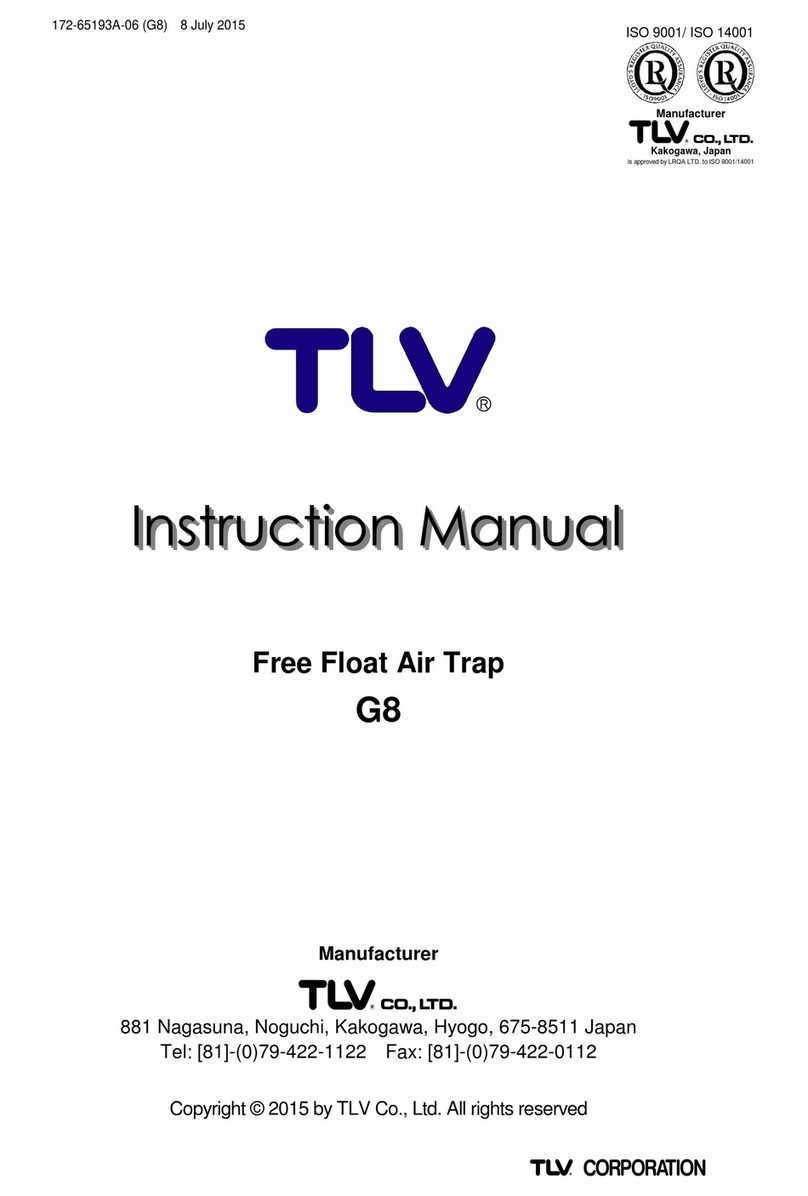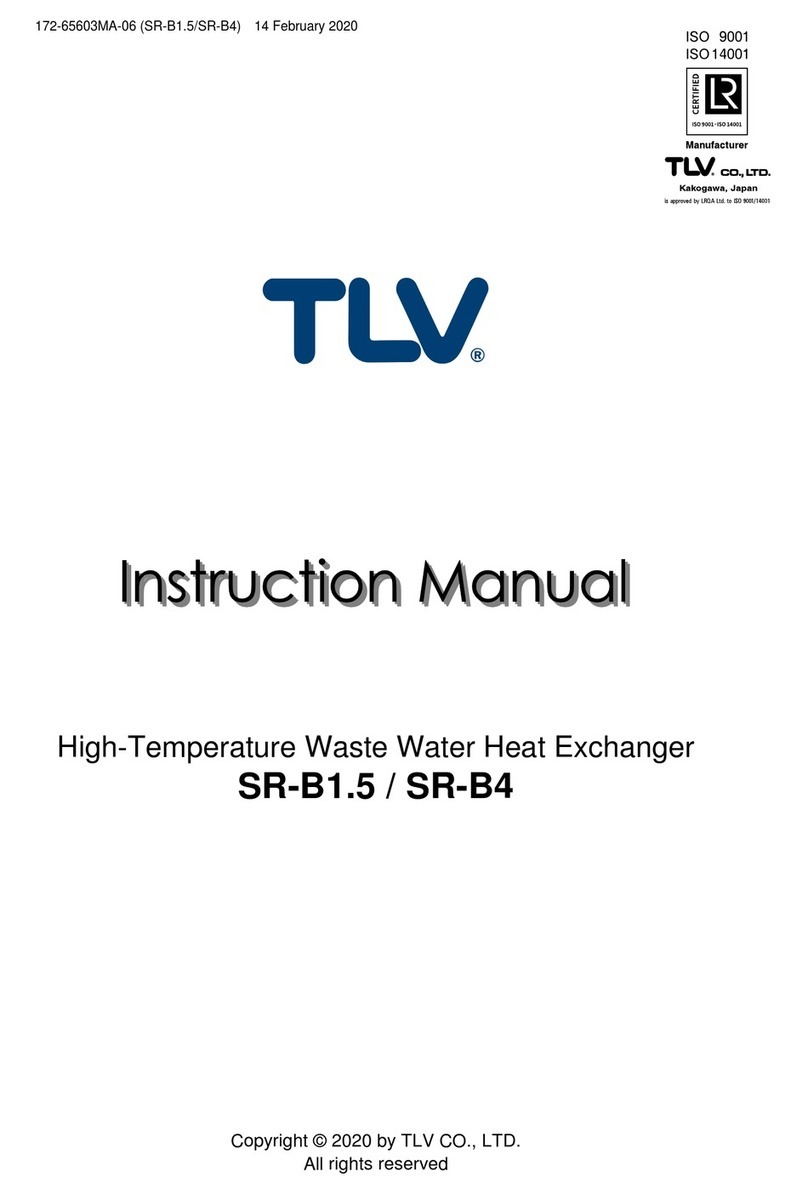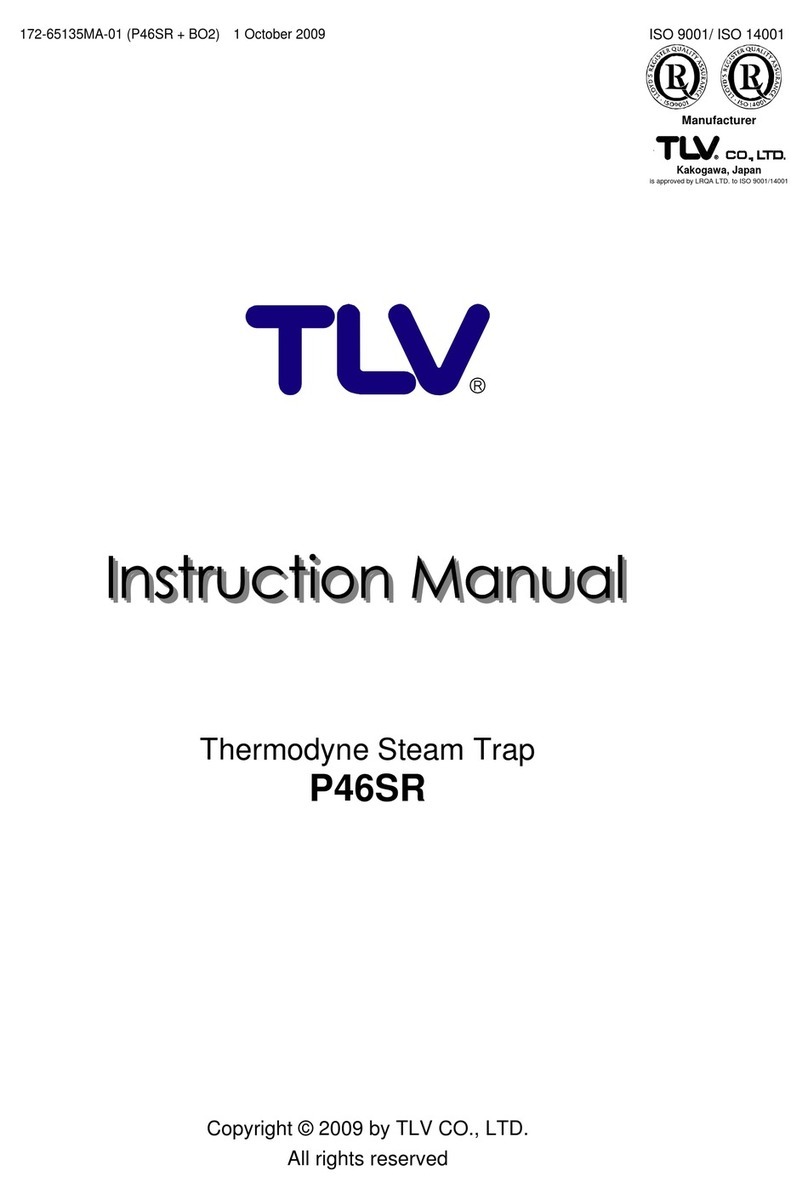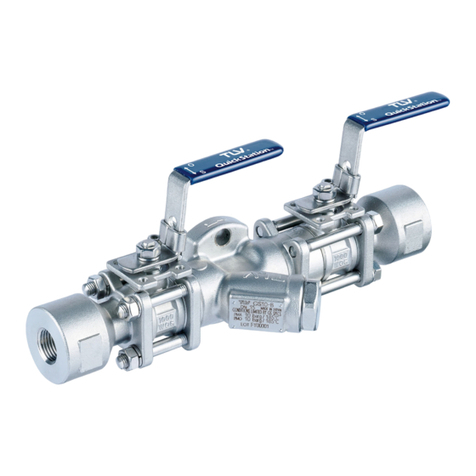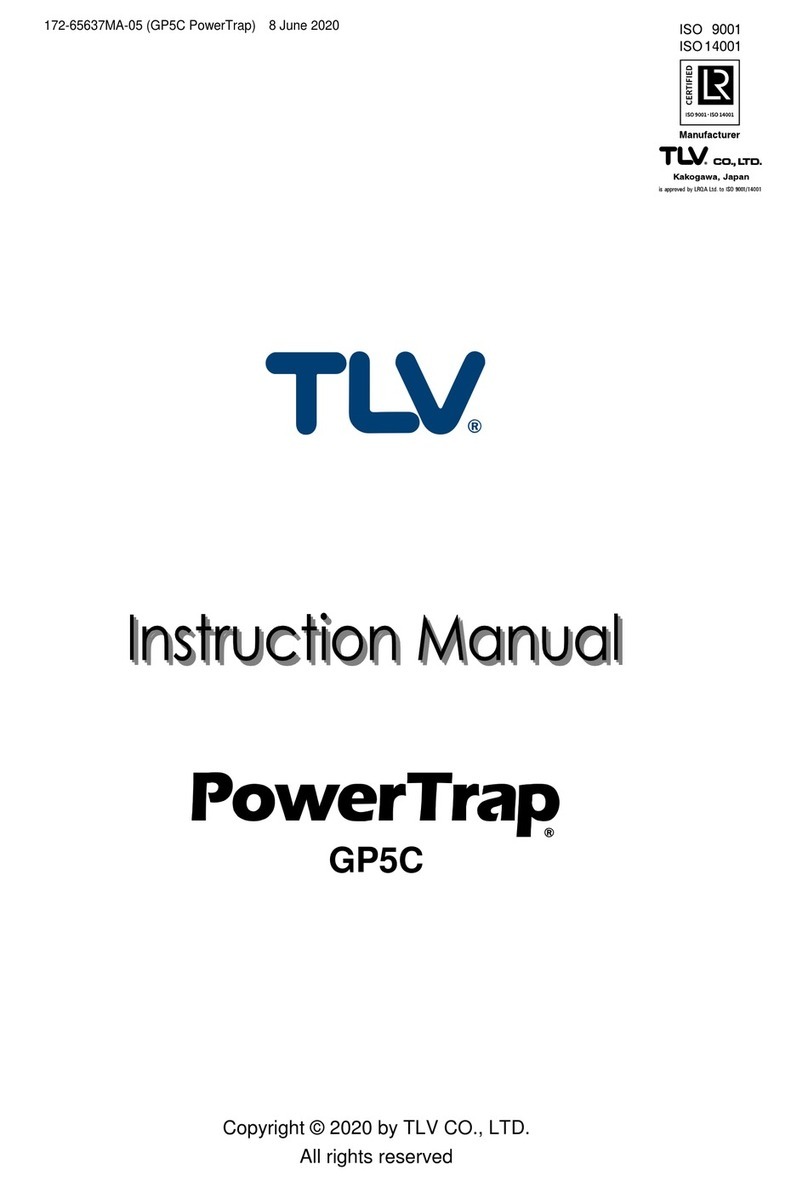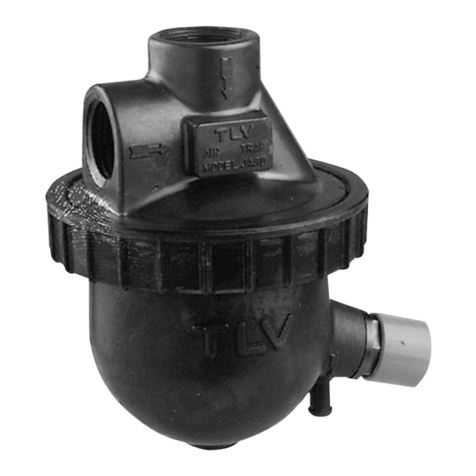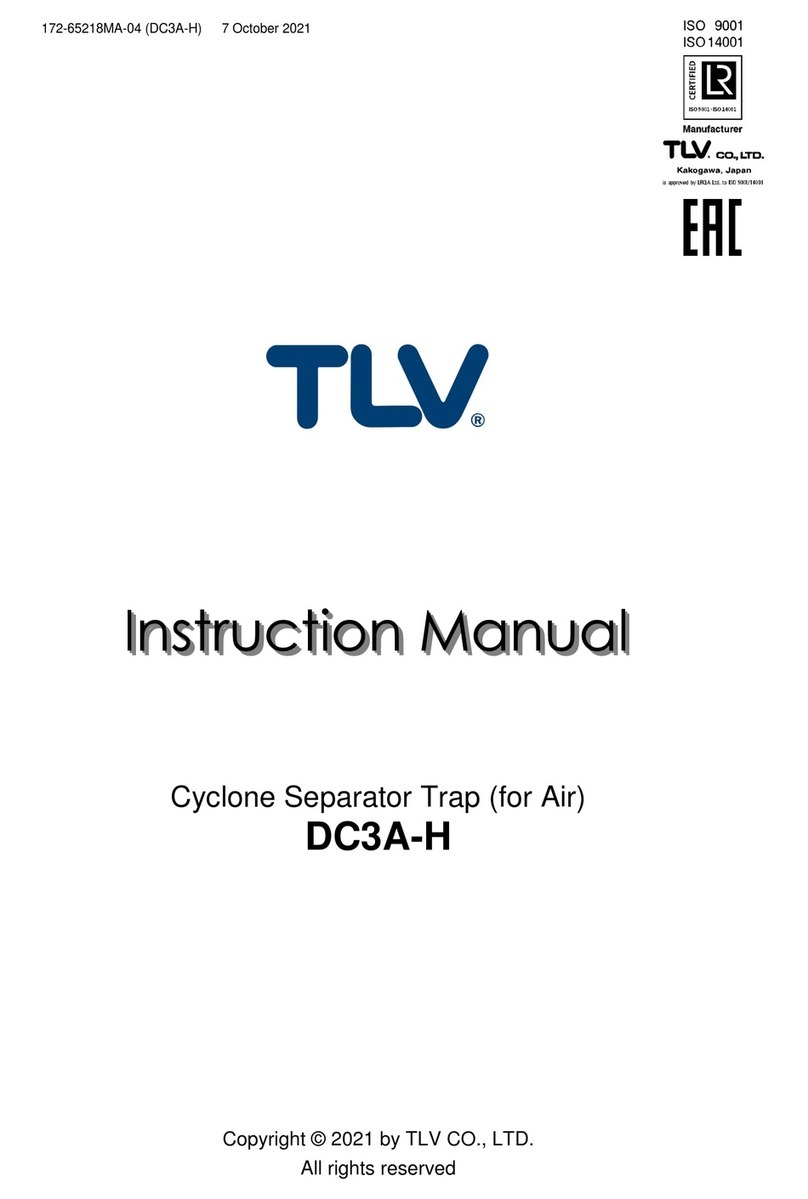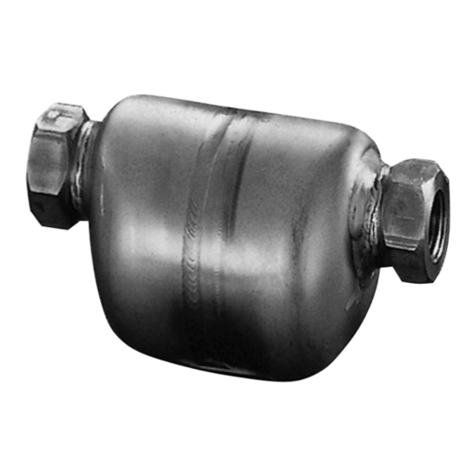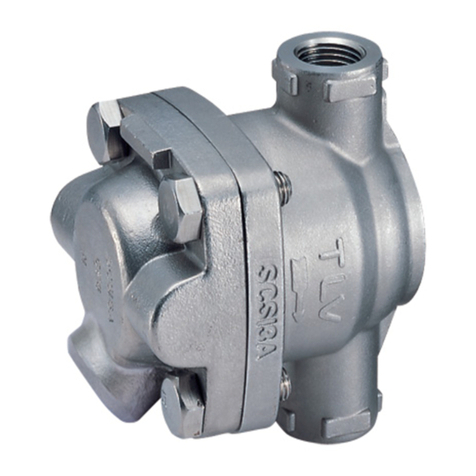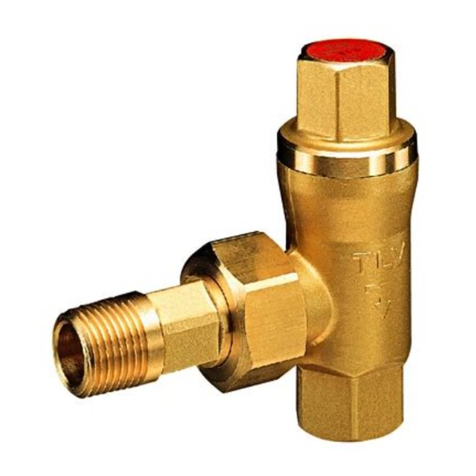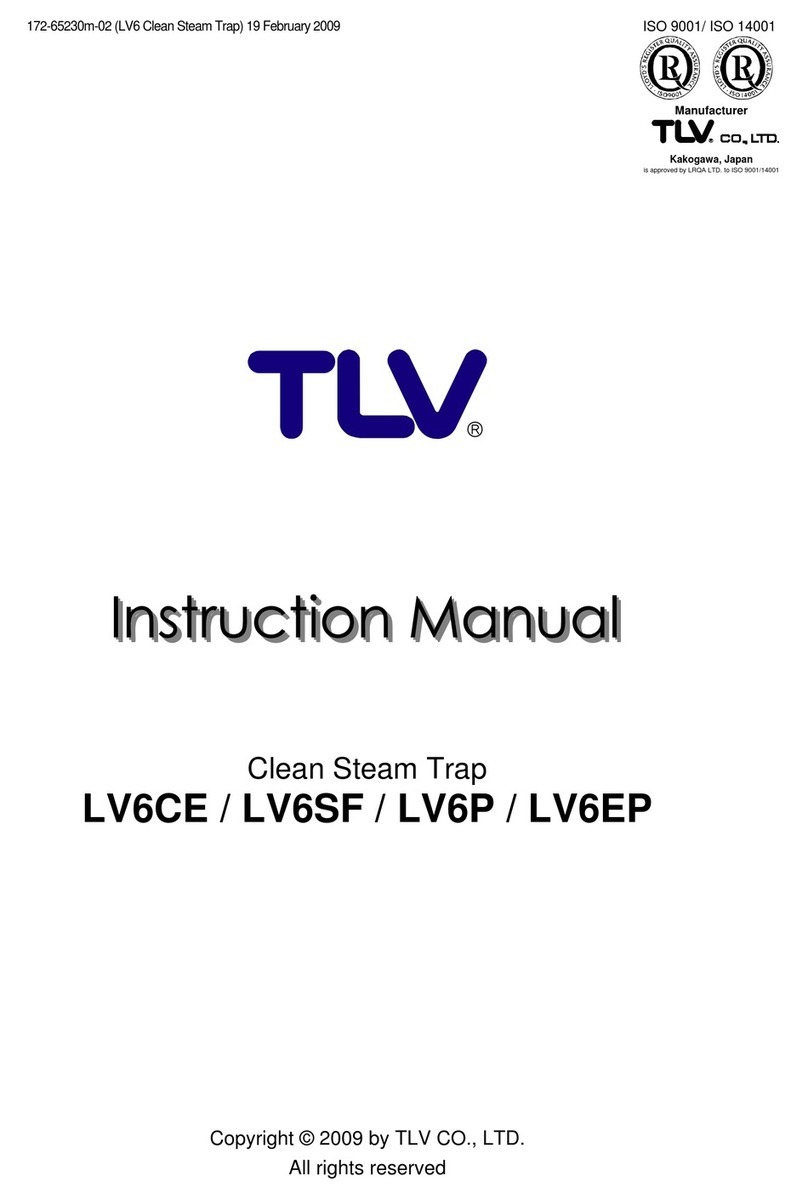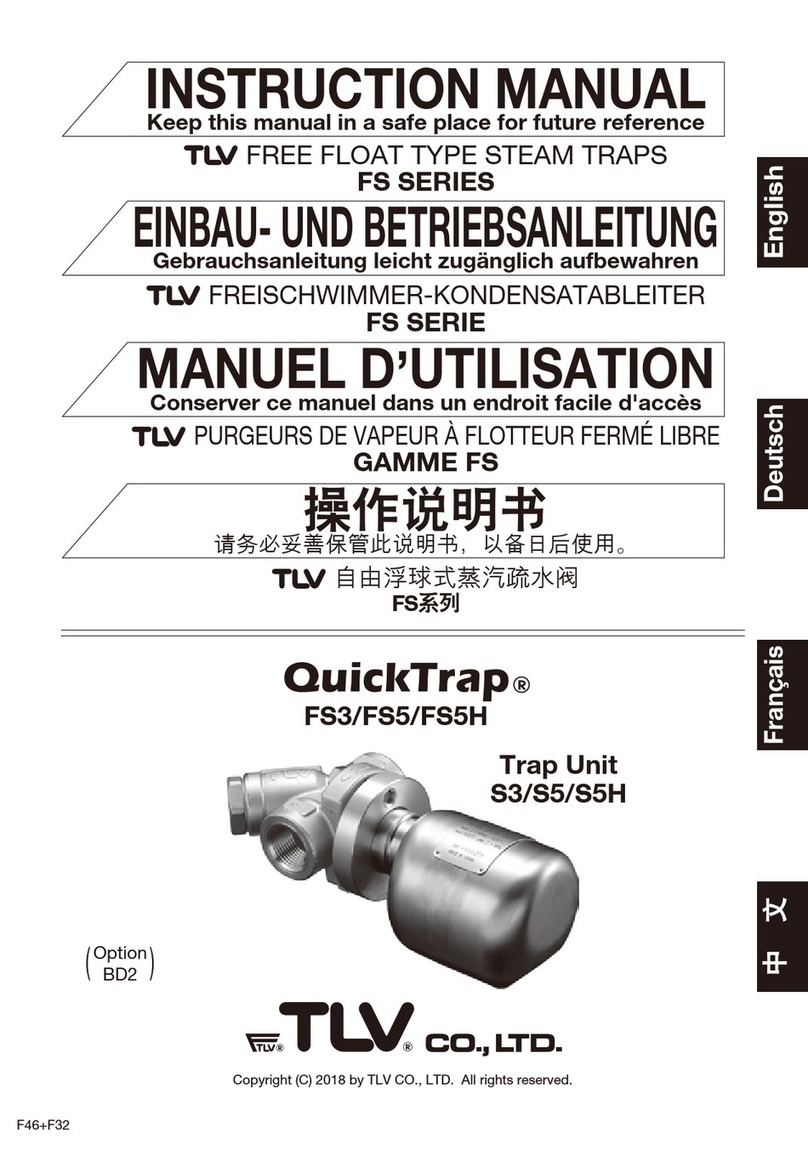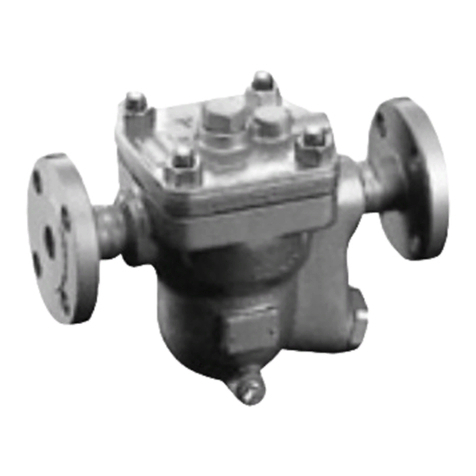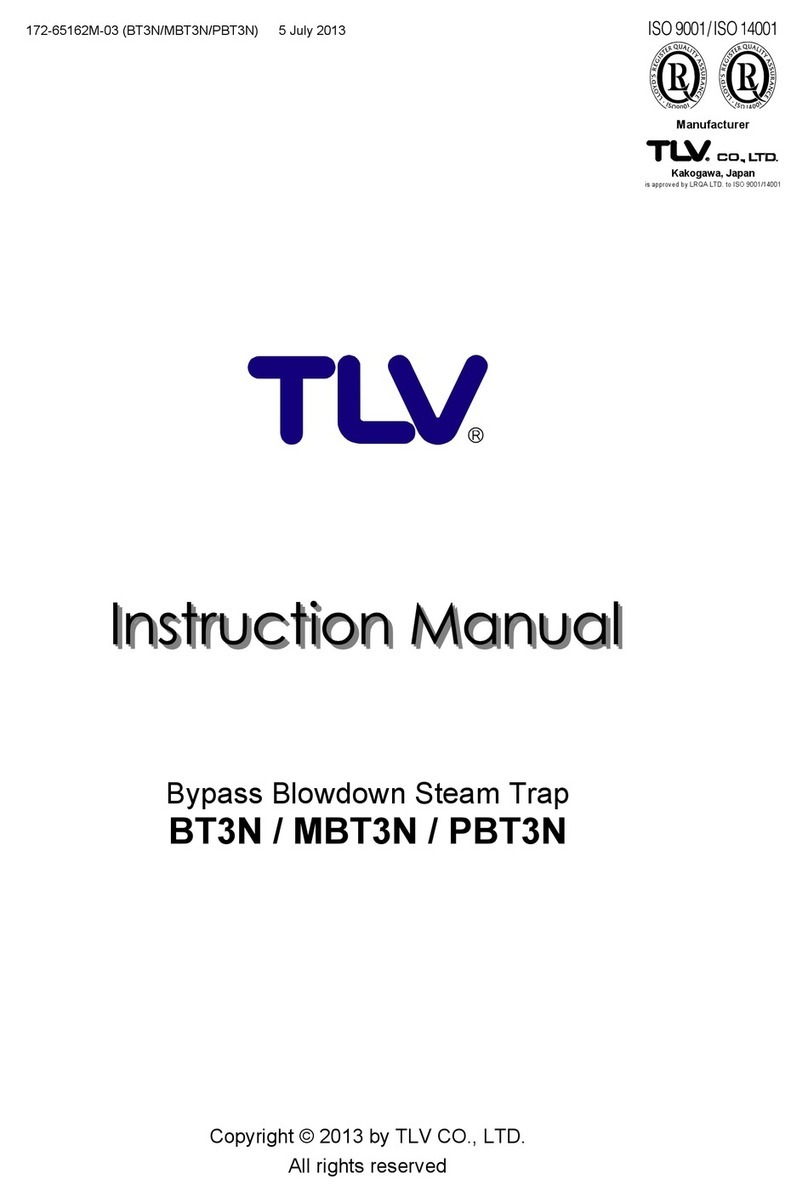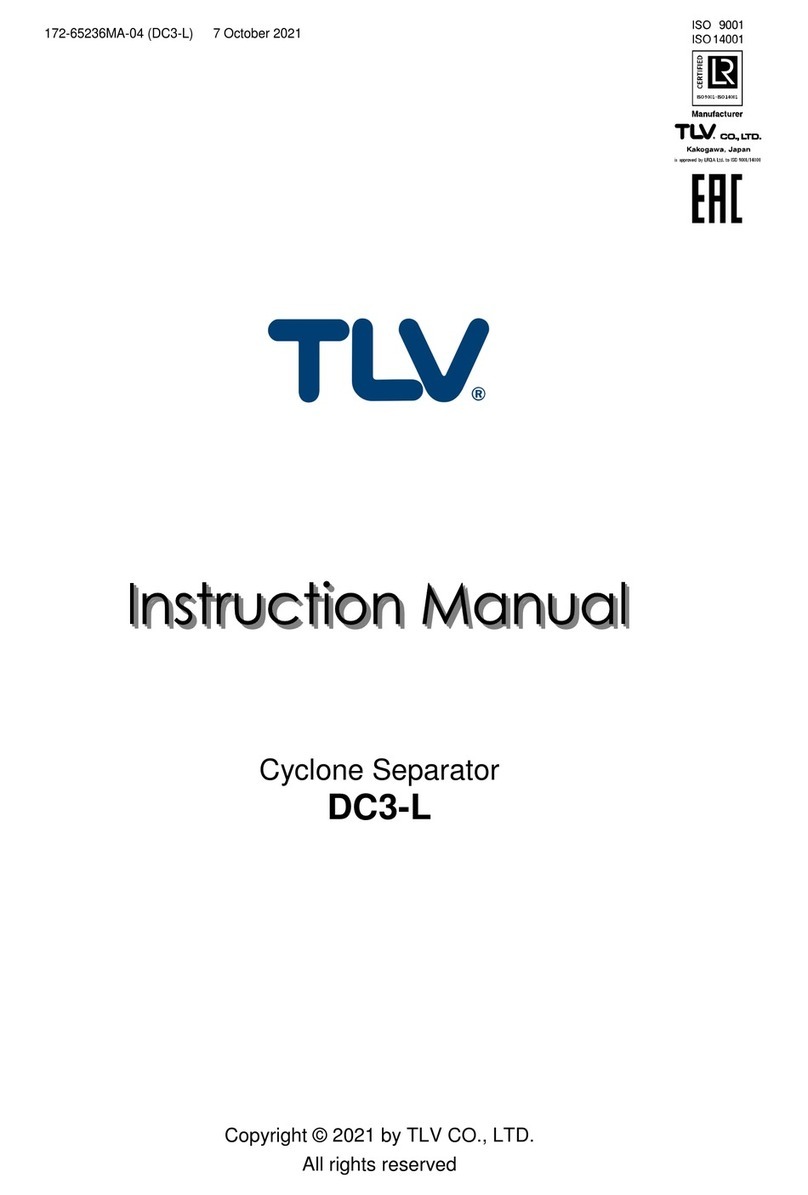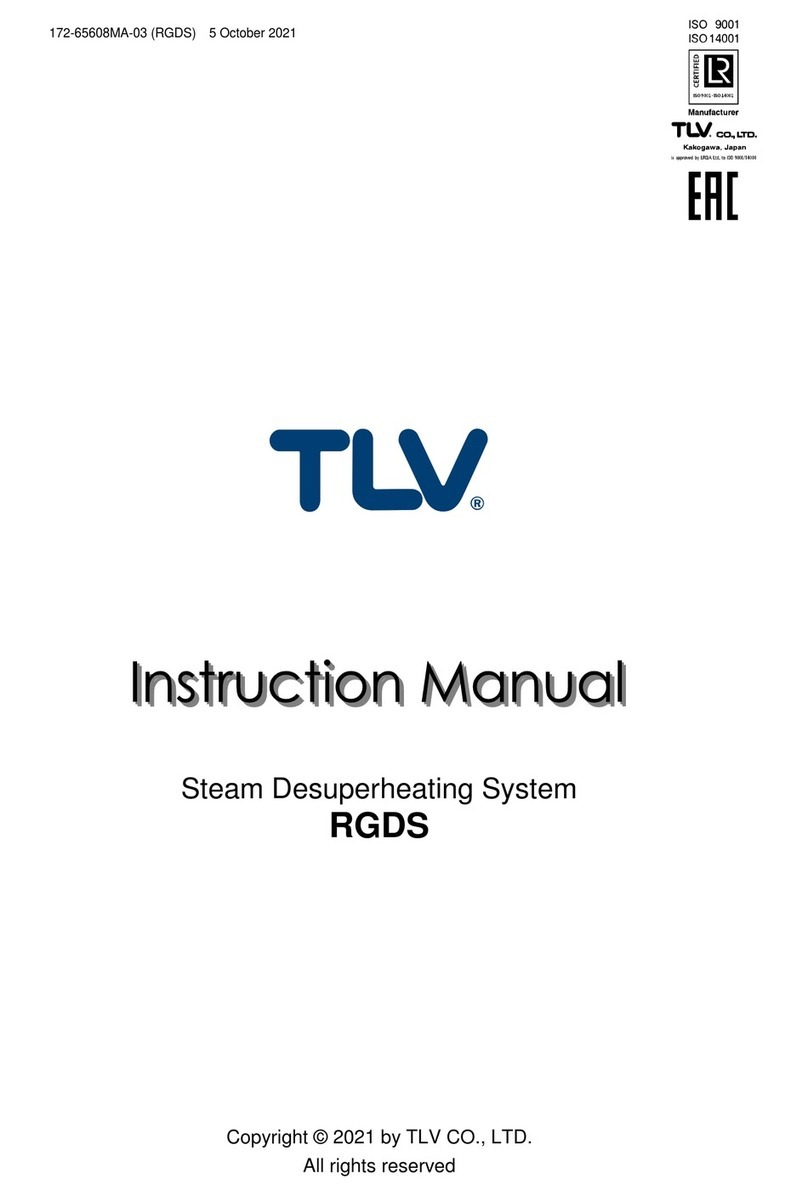TLV JA Series User manual

FREE FLOAT AIR TRAPS
JA SERIES
JA3
JAF3
JA5
JAF5
JA7
INSTRUCTION MANUAL
Keep this manual in a safe place for future reference
Copyright (C) 2021 by TLV CO., LTD. All rights reserved.
881 Nagasuna, Noguchi, Kakogawa, Hyogo 675-8511, Japan
Manufacturer
Tel: [81]-(0)79-422-1122 Fax: [81]-(0)79-422-0112

Introduction
Before you begin, please read this manual to ensure correct usage of the product and keep
it in a safe place for future reference.
The inline repairable air traps of the JA Series are suitable for air systems with pressures up to
1.6 MPaG (230 psig) and temperatures up to 100˚C (212˚F). The traps discharge condensate
continuously and automatically without adjustment.
1 MPa = 10.197 kg/cm2 1 bar = 0.1 MPa
For products with special specifications or with options not included in this manual, contact TLV
for instructions.
The contents of this manual are subject to change without notice.
1. Safety Considerations
• Read this section carefully before use and be sure to follow the instructions.
• Installation, inspection, maintenance, repairs, disassembly, adjustment and valve
opening/closing should be carried out only by trained maintenance personnel.
• The precautions listed in this manual are designed to ensure safety and prevent equipment
damage and personal injury. For situations that may occur as a result of erroneous handling,
three different types of cautionary items are used to indicate the degree of urgency and the
scale of potential damage and danger: DANGER, WARNING and CAUTION.
• The three types of cautionary items above are very important for safety; be sure to observe
all of them, as they relate to installation, use, maintenance, and repair. Furthermore, TLV
accepts no responsibility for any accidents or damage occurring as a result of failure to
observe these precautions.
WARNING
CAUTION
NEVER apply direct heat to the float. The float may explode due to
increased internal pressure, causing accidents leading to serious injury
or damage to property and equipment.
DO NOT use for toxic, flammable or otherwise hazardous fluids.
This product is an air trap that discharges condensate from air piping
systems. Use only for air and/or air condensate. This product is for
intended use only. Improper use may result in such hazards as damage
to the product or malfunctions that may lead to serious accidents.
Install properly and DO NOT use this product outside the recommended
operating pressure, temperature and other specification ranges.
Improper use may result in such hazards as damage to the product or
malfunctions, which may lead to serious accidents. Local regulations may
restrict the use of this product to below the conditions quoted.
Take measures to prevent people from coming into direct contact
with product outlets. Failure to do so may result in burns or other injury
from the discharge of fluids.
Use hoisting equipment for heavy objects (weighing approximately
20 kg (44 Ibs.) or more). Failure to do so may result in back strain or
other injury if the object should fall.
DO NOT use this product in excess of the maximum operating pressure
differential. Such use could make discharge impossible (blocked).
Do not subject this product to condensate loads that exceed its
discharge capacity. Failure to observe this precaution may lead to
condensate accumulation upstream of the trap, resulting in reduced
equipment performance or damage to the equipment.
Indicates an urgent situation
which poses a threat of death
or serious injury.
Indicates that there is a
potential threat of death or
serious injury.
WARNINGDANGER CAUTION
Indicates that there is a
possibility of injury or equip-
ment/product damage.
Continued on the next page
1

CAUTION
When disassembling or removing the product, wait until the internal
pressure equals atmospheric pressure and the surface of the
product has cooled to room temperature. Disassembling or removing
the product when it is hot or under pressure may lead to discharge of
fluids, causing burns, other injuries or damage.
Be sure to use only the recommended components when repairing
the product, and NEVER attempt to modify the product in any way.
Failure to observe these precautions may result in damage to the product
or burns or other injury due to malfunction or the discharge of fluids.
Use only under conditions in which no freeze-up will occur. Freezing
may damage the product, leading to fluid discharge, which may cause
burns or other injury.
Use under conditions in which no water hammer will occur. The
impact of water hammer may damage the product, leading to fluid
discharge, which may cause burns or other injury.
Do not use excessive force when connecting threaded pipes to the
product. Overtightening may cause breakage leading to fluid discharge,
which may cause burns or other injury.
2. Specifications
To avoid malfunctions, product damage, accidents or serious injury, install
properly and DO NOT use this product outside the specification range. Local
regulations may restrict the use of this product to below the conditions quoted.
CAUTION
Refer to the product nameplate for detailed specifications.
* Maximum allowable pressure (PMA) and maximum allowable temperature (TMA) are
PRESSURE SHELL DESIGN CONDITIONS, NOT OPERATING CONDITIONS.
** "Valve No." is displayed for products with options. This item is omitted from the
nameplate when there are no options.
A Model
B Nominal Diameter
C Maximum Allowable Pressure*
D Maximum Allowable Temperature* TMA
E Maximum Differential Pressure
F Maximum Operating Temperature
G Production Lot No.
H Valve No.**
A
G
D
E
B
H
C
F
E
F
H
B
A
D
C
G
2

@3w
o
!3
!0
@4
qe
@0
yt !4r!5
u
!6 !7
@2
i!9 !8
!1
@1
!2
@3w
o
!3
!0
@4
q e
@0
yt !4r !5
u
!6 !7
@2
i
!9 !8
!1
@1
!2
@3 w!3
qe
@0
yt !4r!5
u
!6 !7
@2
i
!9 !8
!1
@1
!2
@5
@7
@6
o
3. Configuration
JA3 · JAF3
JA5
JA7
JAF5
@8 @9

*M = Maintenance kit; R = Repair kit; F = Float
Replacement parts are only available in their respective kits
** Option for JA3/JAF3, JA5/JAF5
No.
1
2
3
4
5
6
7
8
9
10
11
12
13
14
15
16
17
18
19
20
21
22
23
24
25
26
27
Description
JA3/JAF3 JA5/JAF5
JA7
M* R* F* M* R* F* M* R* F*
Body
Cover
Float
Holder Nut Gasket
Valve Seat Holder
O-Ring
Valve Seat
Nameplate
Valve Seat Holder Nut
Drain Plug**
Drain Plug Gasket**
Cover Gasket
Screen
Cover Bolt
Needle
Needle O-Ring
Coil Spring
Split Pin
Plunger
Guard Bushing
Valve Seat Holder
Snap Ring
Washer
Balancing Line Plug
Alignment Pin
Screen Holder
Screen Holder Retainer
Snap Ring
4

4. Proper Installation
1. Before installation, be sure to remove all protective seals.
2. Before installing the trap, blow out the inlet piping to remove all dirt and oil.
3. Install a bypass valve to discharge condensate, and inlet and outlet valves to isolate the trap
in the event of trap failure or maintenance.
4. Install the trap in the lowest part of the pipeline or equipment so the condensate flows
naturally downward into the trap by gravity. The inlet pipe should be as short and have as
few bends as possible.
5. Install the trap within the allowable inclination, as shown below. Also make sure that the
arrow mark on the body corresponds with the direction of flow.
6. Install a check valve at the trap outlet whenever the condensate discharge pipe leads to a
tank or recovery line; or whenever the condensate collection pipeline is connected to more
than one trap.
7. When completing the piping, support the pipes within 0.8 meters (2.5 ft.) on either side of
the trap.
8. To ensure proper condensate flow into the trap, remove the balancing line plug and install a
pressure-balancing line. Connect the end of the line to the air system at a place above any
possible condensate accumulation as shown on page 6.
9. To facilitate inspection and maintenance, install a union or flange where the trap has
connections (condensate inlet & outlet, pressure balancing line).
10. Prime the trap with water through the balancing port or line to ensure a seal.
11. Open the inlet and outlet valves and check to make sure that the trap functions properly.
• Installation, inspection, maintenance, repairs, disassembly, adjustment
and valve opening/closing should be done only by trained maintenance
personnel.
• Take measures to prevent people from coming into direct contact with
product outlets.
• Do not use excessive force when connecting threaded pipes.
• Use hoisting equipment for heavy objects.
• Install for use under conditions in which no freeze-up will occur.
• Install for use under conditions in which no water hammer will occur.
CAUTION
5˚
5˚
5˚
Allowable Inclination
Horizontal inclination Vertical inclination
5

Check to make sure that the pipes connected to the trap have been installed properly.
1. Is the pipe diameter suitable?
2. Has the trap been installed within the allowable inclination and with the arrow on the body
pointing in the direction of flow?
3. Has sufficient space been secured for maintenance?
4. Have maintenance valves been installed at inlet and outlet? If the outlet is subject to back
pressure, has a check valve been installed?
5. Is the inlet pipe as short as possible, with as few bends as possible, and installed so that the
condensate will flow naturally down into the trap?
6. Has the piping work been done with the proper methods as shown in the table above?
7. Has the pressure-balancing line been connected to the trap and the receiver tank or the air
section of the main as shown below?
5. Piping Arrangement
Requirement
Diameter is too
small.
Diameter is too
small and inlet
protrudes into pipe.
Rust and scale
flow into the trap
with the
condensate.
Condensate
collects in the
pipe.
Correct Incorrect
Install a catchpot with the
proper diameter.
Make sure the flow of
condensate is not
obstructed.
To prevent rust and scale
from flowing into the trap,
connect the inlet pipe
25 - 50 mm (1 - 2 in) above
the base of the T - pipe.
When installing on the
blind end, make sure
nothing obstructs the flow
of condensate.
Receiver Tank Air Main
Pressure-balancing
line
Pressure-
balancing
line
6. Operational Check
A visual inspection can be done to help decide about necessary immediate maintenance or repair
if the trap is open to atmosphere. Use diagnostic equipment; such as a stethoscope, thermometer
if the trap does not discharge to atmosphere.

Periodic operational inspections should be performed at least biannually or at intervals
according to use. Faulty air traps may result in losses due to air leakage.
Normal: Condensate is discharged continuously and the sound of flow like that of water
draining from a bathtub can be heard. With very little condensate, there is almost
no sound of flow.
Blocked: No condensate is discharged. The trap is quiet and makes no noise The surface
temperature of the trap is low.
Blowing: Air continually flows from the outlet and there is a continuous sound of a forceful
stream against a surface.
Air Leakage: Air is discharged through the trap outlet together with the condensate and there is
a hissing sound.
7. Inspection and Maintenance
WARNING
NEVER apply direct heat to the float. The float may explode due to
increased internal pressure, causing accidents leading to serious injury or
property and equipment damage.
• Installation, inspection, maintenance, repairs, disassembly, adjustment and
valve opening/closing should be done only by trained maintenance
personnel.
• Before attempting to open the trap, close the inlet and outlet isolating valves, and the valve in the
equalizing pipe and wait until the trap has cooled to room temperature. Reduce the internal
pressure to atmospheric pressure by slowly and cautiously turning the drain plug a few degrees
so that condensate and air can escape. Then open the drain plug completely to drain the
condensate from inside the body. Failure to do so may result in burns or injuries.
• Be sure to use the proper components and NEVER try to modify the product.
CAUTION
Consult the table of tightening torques
and tighten to the proper torque (page 8)
Part & No.
JA3/JAF3 JA5/JAF5
JA7
Remove with a socket
wrench
Wrap threads with sealing tape,
consult the table of tightening
torques and tighten to the proper
torque (page 8)
Remove with a wrench
Replace with a new gasket,
coat with anti-seize
—
Consult the table of tightening torques
and tighten to the proper torque (page 8)
Remove with
a socket wrench
Make sure the arrow on the cover is
pointing in the direction of flow (JA7)
Align the cover with the alignment pin
(except JA7) and reattach
Lift the cover up and off
Insert into the hole in the body
Remove the alignment pin
Replace with a new gasket if damaged
Remove the gasket
During Disassembly During Reassembly
Body, Cover
Gaskets
Screen
Float
Valve Seat
Check inside for dirt, grease, oil film, rust or scale.
Check for warping or damage.
Check for clogging, corrosion or damage.
Check for deformation, damage, oil film or water inside.
Check for rust, scale, oil film, wear or damage.
Parts Inspection Procedure
If the trap shows signs of blockage, blowing or air leakage, perform manual blowdown by pushing
the plunger in several times with a fingertip to allow dirt and oil to be discharged through the
orifice. If this does not remedy the problem, follow the instructions under chapter 8,
“Troubleshooting”.
Disassembly/Reassembly (to reassemble, follow procedures in reverse)
Drain Plug
9
Drain Plug
Gasket 10
Cover Bolt
13
Cover 2
Alignment Pin 24
Cover Gasket 11
" " indicates which models contain which parts.
*Option
**
**

24
( )
21
( )
12
( )
17
( )
* Torque values with sealing tape wrapped 3 ~ 3.5 turns around the threads.
** Option for JA3·JAF3, JA5·JAF5
If drawings or other special documentation were supplied for the product, any torque given there
takes precedence over values shown here.
/
8
7
/
32
15
/
16
13
/
4
1
1
1 N.m ≈10 kg.cm
" " indicates which models contain which parts
Part & No.
JA3/JAF3 JA5/JAF5
JA7
Remove with a wrench
Pinch the insides together
and remove from body
During Disassembly During Reassembly
Disassembly/Reassembly (to reassemble, follow procedures in reverse)
Balancing
Line Plug 23
(When connecting
the line for the
first time)
Snap Ring 27
Screen 12
Screen Holder
Retainer 26
Screen Holder
25
Float 3
Guard Bushing
19
Valve Seat
Holder Nut 8
Holder Nut Gasket 4
Valve Seat
Holder 20
Valve Seat
Holder
O-Ring* 5
Snap Ring 21
(for Valve Seat
Holder Nut)
Washer 22
Valve Seat 6
Split Pin* 17
Plunger* 18
Coil Spring* 16
Needle* 14
Needle
O-Ring* 15
—
(Connect the pressure-balancing line)
When the pressure-balancing line is not necessary, wrap
threads with sealing tape, consult the table of tightening
torques and tighten to the proper torque (see below)
Insert securely into the snap ring
groove in the body
Remove by lifting straight
up and out while turning
Turn gently while inserting, make sure the top
of the screen does not stick up out of the body
Use fingers to remove from
the valve seat holder nut
Use fingers to tighten loosely
Pinch the insides together
and remove from the valve
seat holder (Fig. A)
Insert securely into groove up against the
washer be sure that the break in the snap
ring lines up with the slot in the groove
Be careful not to lose
Remove from needle
—
Be careful not to damage
the O-ring as it is made
of rubber
Remove without bending
Coat with heat resistant
grease**; replace with a
new O-ring if warped or
damaged; fit securely into
the groove in the needle
Be careful not to damage
the rubber valve seat
Replace with a new valve seat if sealing
surfaces are warped or damaged
Be careful not to damage
the O-ring as it is made of
rubber
Coat with heat resistant grease**; replace with a
new O-ring if warped or damaged; fit securely
into the groove in the valve seat holder
Push out from inside the body
toward the valve seat holder nut
Pushing it in until it contacts the
stopper inside
—
——
—
—
—
—
Replace with a new gasket if damaged
Remove with a socket
wrench
Consult the table of tightening torques and
tighten to the proper torque (see below)
Remove, being careful not
to scratch the polished surface
Insert, being careful not to scratch or
misshape
Remove by lifting up and out
Make sure thet correct side is facing up
Remove without bending
Place on the ledge inside the body,
making sure the rounded side is on top
Remove by lifting up and
out
Place on the screen holder without tilting
*Detach / Reassemble only when the needle is replaced
**Use silicone grease (for heat resistant grease)
Tightening Torque (T) and Distance Across Flats (D)
Fig. A
Valve Seat
Holder
Snap Ring
Pinch the insides
together and remove
/
32
21
/
16
15
/
32
15
/
16
13
/
32
21
/
32
15
/
32
15
/
32
13
1
(T) N.m
(lbf.ft)
(D) mm
(in)
Model
JA3/JAF3 50
(37)
50
(37)
30*
(22*)
35**
(26**)
32
( )
21
( )
12
( )
22
( )
JA5/JAF5 80
(59)
80
(59)
30*
(22*)
35**
(26**)
36
( )
12
( )
12
( )
17
( )
JA7 70
(51)
120
(88)
30*
(22*)
30*
(22*)
Cover Bolt (13)
(T) N.m
(lbf.ft)
(D) mm
(in)
Valve Seat Holder Nut (8)
(T) N.m
(lbf.ft)
(D) mm
(in)
Balancing Line Plug (23)
(T) N.m
(lbf.ft)
(D) mm
(in)
Drain Plug (9)

8. Troubleshooting
If the expected performance is unachievable after installation of the air trap, read chapter 4.
"Proper Installation" and chapter 5. "Piping Arrangement" again and check the following points
to take appropriate corrective measures.
Problem Cause Remedy
Float is damaged or filled with condensate
Orifice, screen or piping is clogged with
rust, scale or dirt
The trap operating pressure exceeds the
maximum specified pressure, or there is
insufficient differential pressure between
the trap inlet and outlet
Air binding occurs
Orifice is clogged or rust and scale have
accumulated under the float
Orifice is damaged
Float is deformed or coated with scale
Trap is installed above the maximum
allowable inclination angle
Vibration of trap occurs
There is no condensate in the air trap
body, no water seal around the valve seat
Deterioration of or damage to gaskets
Improper tightening torque for cover was
used
Water hammer occurs
No condensate is
discharged
(blocked) or
discharge is poor
Air is discharged
or leaks from the
trap outlet
(blowing)
(air leakage)
Air leaks from a
place other
than the trap
outlet
Float is frequently
damaged
Replace the float
Clean
Compare specifications and
actual operating conditions
Check and correct balance
pipe and inlet pipe arrange-
ment
Clean
Replace the orifice
Clean or replace the float
Correct the installation
Lengthen inlet piping, then
fasten it securely
Prime the air trap with water
Replace the gaskets
Tighten to the proper torque
Examine the piping for
problems that can cause
water hammer and repair

9. TLV EXPRESS LIMITED WARRANTY
Subject to the limitations set forth below, TLV Corporation, a North Carolina corporation (“TLV”)
warrants that products which are sold by it, TLV CO., LTD., a Japanese corporation (“TLVJ”) or
TLV International, Inc., a Japanese corporation (“TII”), (hereinafter the “Products”) are designed
and manufactured by TLVJ, conform to the specifications published by TLV for the corresponding
part numbers (the “Specifications”) and are free from defective workmanship and materials. With
regard to products or components manufactured by unrelated third parties (the “Components”),
TLV provides no warranty other than the warranty from the third party manufacturer(s), if any.
Exceptions to Warranty
This warranty does not cover defects or failures caused by:
1. improper shipping, installation, use, handling, etc., by other than TLV or service
representatives authorized by TLV; or
2. dirt, scale or rust, etc.; or
3. improper disassembly and reassembly, or inadequate inspection and maintenance by other
than TLV or service representatives authorized by TLV; or
4. disasters or forces of nature or Acts of God; or
5. abuse, abnormal use, accidents or any other cause beyond the control of TLV; or
6. improper storage, maintenance or repair; or
7. operation of the Products not in accordance with instructions issued with the Products or with
accepted industry practices; or
8. use for a purpose or in a manner for which the Products were not intended; or
9. use of the Products in a manner inconsistent with the Specifications; or
10. use of the Products with Hazardous Fluids (fluids other than steam, air, water, nitrogen,
carbon dioxide and inert gases (helium, neon, argon, krypton, xenon and radon)); or
11. failure to follow the instructions contained in the TLV Instruction Manual for the Product.
Duration of Warranty
This warranty is effective for a period of the earlier of: (i) three (3) years after delivery of Products
to the first end user in the case of sealed SST-Series Products for use in steam pressure service
up to 650 psig; (ii) two (2) years after delivery of Products to the first end user in the case of
PowerTrap® units; or (iii) one (1) year after delivery of Products to the first end user in the case of
all other Products. Notwithstanding the foregoing, asserting a claim under this warranty must be
brought by the earlier of one of the foregoing periods, as applicable, or within five (5) years after
the date of delivery to the initial buyer if not sold initially to the first end user.
ANY IMPLIED WARRANTIES NOT NEGATED HEREBY WHICH MAY ARISE BY OPERATION OF
LAW, INCLUDING THE IMPLIED WARRANTIES OF MERCHANTABILITY AND FITNESS FOR A
PARTICULAR PURPOSE AND ANY EXPRESS WARRANTIES NOT NEGATED HEREBY, ARE
GIVEN SOLELY TO THE INITIAL BUYER AND ARE LIMITED IN DURATION TO ONE (1) YEAR
FROM THE DATE OF SHIPMENT BY TLV.
Exclusive Remedy
THE EXCLUSIVE REMEDY UNDER THIS WARRANTY, UNDER ANY EXPRESS WARRANTY OR
UNDER ANY IMPLIED WARRANTIES NOT NEGATED HEREBY (INCLUDING THE IMPLIED
WARRANTIES OF MERCHANTABILITY AND FITNESS FOR A PARTICULAR PURPOSE), IS
REPLACEMENT;
PROVIDED: (a) THE CLAIMED DEFECT IS REPORTED TO TLV IN WRITING
WITHIN THE APPLICABLE WARRANTY PERIOD, INCLUDING A DETAILED WRITTEN
DESCRIPTION OF THE CLAIMED DEFECT AND HOW AND WHEN THE CLAIMED DEFECTIVE
PRODUCT WAS USED; AND (b) THE CLAIMED DEFECTIVE PRODUCT AND A COPY OF THE
PURCHASE INVOICE IS RETURNED TO TLV, FREIGHT AND TRANSPORTATION COSTS
PREPAID, UNDER A RETURN MATERIAL AUTHORIZATION AND TRACKING NUMBER ISSUED
BY TLV. ALL LABOR COSTS, SHIPPING COSTS, AND TRANSPORTATION COSTS
ASSOCIATED WITH THE RETURN OR REPLACEMENT OF THE CLAIMED DEFECTIVE
PRODUCT ARE SOLELY THE RESPONSIBILITY OF BUYER OR THE FIRST END USER. TLV
RESERVES THE RIGHT TO INSPECT ON THE FIRST END USER’S SITE ANY PRODUCTS
CLAIMED TO BE DEFECTIVE BEFORE ISSUING A RETURN MATERIAL AUTHORIZATION.
SHOULD SUCH INSPECTION REVEAL, IN TLV’S REASONABLE DISCRETION, THAT THE
10

13901 South Lakes Drive, Charlotte, NC 28273-6790, U.S.A.
Tel: [1]-704-597-9070 Fax: [1]-704-583-1610
Printed on recycled paper.
Rev. 10/2021 (M)PAC-65341-a
CLAIMED DEFECT IS NOT COVERED BY THIS WARRANTY, THE PARTY ASSERTING THIS
WARRANTY SHALL PAY TLV FOR THE TIME AND EXPENSES RELATED TO SUCH ON-SITE
INSPECTION.
Exclusion of Consequential and Incidental Damages
IT IS SPECIFICALLY ACKNOWLEDGED THAT THIS WARRANTY, ANY OTHER EXPRESS
WARRANTY NOT NEGATED HEREBY, AND ANY IMPLIED WARRANTY NOT NEGATED
HEREBY, INCLUDING THE IMPLIED WARRANTIES OF MERCHANTABILITY AND FITNESS FOR
A PARTICULAR PURPOSE, DO NOT COVER, AND NEITHER TLV, TII NOR TLVJ WILL IN ANY
EVENT BE LIABLE FOR, INCIDENTAL OR CONSEQUENTIAL DAMAGES, INCLUDING, BUT NOT
LIMITED TO LOST PROFITS, THE COST OF DISASSEMBLY AND SHIPMENT OF THE
DEFECTIVE PRODUCT, INJURY TO OTHER PROPERTY, DAMAGE TO BUYER’S OR THE FIRST
END USER’S PRODUCT, DAMAGE TO BUYER’S OR THE FIRST END USER’S PROCESSES,
LOSS OF USE, OR OTHER COMMERCIAL LOSSES. WHERE, DUE TO OPERATION OF LAW,
CONSEQUENTIAL AND INCIDENTAL DAMAGES UNDER THIS WARRANTY, UNDER ANY
OTHER EXPRESS WARRANTY NOT NEGATED HEREBY OR UNDER ANY IMPLIED WARRANTY
NOT NEGATED HEREBY (INCLUDING THE IMPLIED WARRANTIES OF MERCHANTABILITY AND
FITNESS FOR A PARTICULAR PURPOSE) CANNOT BE EXCLUDED, SUCH DAMAGES ARE
EXPRESSLY LIMITED IN AMOUNT TO THE PURCHASE PRICE OF THE DEFECTIVE PRODUCT.
THIS EXCLUSION OF CONSEQUENTIAL AND INCIDENTAL DAMAGES, AND THE PROVISION
OF THIS WARRANTY LIMITING REMEDIES HEREUNDER TO REPLACEMENT, ARE
INDEPENDENT PROVISIONS, AND ANY DETERMINATION THAT THE LIMITATION OF
REMEDIES FAILS OF ITS ESSENTIAL PURPOSE OR ANY OTHER DETERMINATION THAT
EITHER OF THE ABOVE REMEDIES IS UNENFORCEABLE, SHALL NOT BE CONSTRUED TO
MAKE THE OTHER PROVISIONS UNENFORCEABLE.
Exclusion of Other Warranties
THIS WARRANTY IS IN LIEU OF ALL OTHER WARRANTIES, EXPRESS OR IMPLIED, AND ALL
OTHER WARRANTIES, INCLUDING BUT NOT LIMITED TO THE IMPLIED WARRANTIES OF
MERCHANTABILITY AND FITNESS FOR A PARTICULAR PURPOSE, ARE EXPRESSLY
DISCLAIMED.
Severability
Any provision of this warranty which is invalid, prohibited or unenforceable in any jurisdiction
shall, as to such jurisdiction, be ineffective to the extent of such invalidity, prohibition or
unenforceability without invalidating the remaining provisions hereof, and any such invalidity,
prohibition or unenforceability in any such jurisdiction shall not invalidate or render unenforceable
such provision in any other jurisdiction.
This manual suits for next models
5
Table of contents
Other TLV Industrial Equipment manuals
